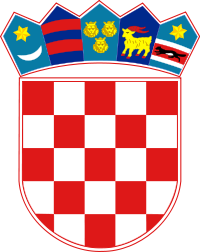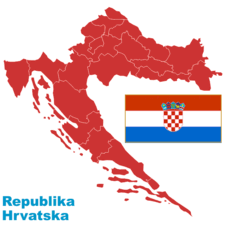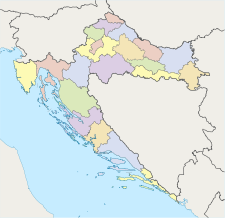Counties of Croatia
| Croatia |
 This article is part of the series: |
|
|
|
Constitution
Legislative
Judiciary
Executive
Political parties
Elections
Divisions
Foreign relations
|
|
Other countries · Atlas |
The primary territorial subdivisions of the Republic of Croatia called županije (singular: županija). In English are commonly referred to as counties, although the Croatian županija derives from župa meaning a parish (Zupanija therefore equates linguistically to civil parish in English). The correct Croatian word for county is grofovija, from grof, meaning count.
There is a total of 21 županije, counting in the City of Zagreb which has status equal to that of a županija.
Contents |
History
Croatia has had sub-divisions since the Middle Ages. However, their sizes, names and positions changed with time.
The Kingdom of Croatia-Slavonia was subdivided in 1867 into eight counties or comitatus. The Kingdom of Dalmatia was similarly divided into districts. The Parliament of Croatia was officially called Sabor Kraljevine Hrvatske, Dalmacije i Slavonije (Latin: Congregatio generalis Regnorum Croatiae, Dalmatiae et Slavoniae). Other institutions also bore that title.
The Kingdom of Serbs, Croats and Slovenes retained the territorial subdivisions of its historical provinces up to 1922. Between 1922 and 1929 the Kingdom continued to be divided with some respect to the borders of historical provinces, but previous units of territorial subdivisions (like the counties) were replaced by the greater units called oblast (in Serbo-Croato-Slovene language). In the territory of Croatia-Slavonia and Dalmatia there were six units: Dubrovačka oblast, Osječka oblast, Primorsko-krajiška oblast (Karlovac), Splitska oblast, Srijemska oblast (Vukovar) and Zagrebačka oblast. The following territorial changes were made: Kastavština was attached to Ljubljanska oblast, Međimurje to Mariborska oblast and the Bay of Kotor to Cetinjska oblast.
With the formation of the Kingdom of Yugoslavia in 1929, most of the territory of the former Kingdom of Croatia-Slavonia became part of the Sava Banovina and some of the territory of the former Kingdom of Dalmatia became part of the Littoral Banovina, but the borders of historical provinces were not respected.
In Socialist Yugoslavia, the Socialist Republic of Croatia was divided into općine (sing. općina) which were smaller than the present counties. The designation općina has been retained for municipalities which are one level smaller than the županije and also smaller than the old općine.
The political representatives elected for županija government used to form a Chamber of županije (Županijski dom) in the Croatian Parliament, between 1993 and 2001.
Present-day županije were introduced in the 1990 Constitution of Croatia, and have only slightly changed since.
Organization
Each županija has an assembly (županijska skupština) which is composed of representatives elected by popular vote, using party-list proportional representation, for four-year terms.
The županija assembly elects the executive county leadership, decides on the yearly budget, the county properties etc.
The leader of a county is a župan (sometimes translated as "prefect"), who has one or two deputies each called a dožupan. The župan presides over the county's executive government (županijsko poglavarstvo), and represents the county in external affairs.
List of counties
The list of županije, grouped into historic and geographic larger regions:

| County | Official name | |
| Central Croatia | ||
|---|---|---|
| Bjelovar-Bilogora | Bjelovarsko-bilogorska županija | |
| Karlovac | Karlovačka županija | |
| Koprivnica-Križevci | Koprivničko-križevačka županija | |
| Krapina-Zagorje | Krapinsko-zagorska županija | |
| Međimurje | Međimurska županija | |
| Sisak-Moslavina | Sisačko-moslavačka županija | |
| Varaždin | Varaždinska županija | |
| Zagreb County | Zagrebačka županija | |
| City of Zagreb | Grad Zagreb | |
| Littoral (Adriatic coast) | ||
| Dubrovnik-Neretva | Dubrovačko-neretvanska županija | |
| Istria | Istarska županija | |
| Lika-Senj | Ličko-senjska županija | |
| Primorje-Gorski Kotar | Primorsko-goranska županija | |
| Split-Dalmatia | Splitsko-dalmatinska županija | |
| Šibenik-Knin | Šibensko-kninska županija | |
| Zadar | Zadarska županija | |
| Slavonia | ||
| Brod-Posavina | Brodsko-posavska županija | |
| Osijek-Baranja | Osječko-baranjska županija | |
| Požega-Slavonia | Požeško-slavonska županija | |
| Virovitica-Podravina | Virovitičko-podravska županija | |
| Vukovar-Syrmia | Vukovarsko-srijemska županija | |
Naming

The county names ending in the suffixes -čka and -ska are adjectives, with the noun županija implied, so e.g. Karlovačka's full name is Karlovačka županija. Some counties prefer to swap the order of those two words but they are in the minority (since February 7, 1997 when the order was officially changed).
Cities
Zagreb itself is grad, a city, due to its importance it has a county status and jurisdiction. Any town with population over 35,000 can take over a part of jurisdiction of its county.
See also
- Etymology of županija
- ISO 3166-2:HR
References
- Mirošević, Franko (editor); Goldstein, Ivo; Grgin, Borislav; Moačanin, Nenad; Potrebica, Filip; Pavličević, Dragutin; Vranješ-Šoljan, Božena; Kolar-Dimitrijević, Mira; Klemenčić, Mladen; Rogić, Veljko; Gmajnić, Ladislav (maps); Hrvatske županije kroz stoljeća, (English: Croatian Counties Across Centuries), Školska knjiga i Zavod za hrvatsku povijest Filozofskoga fakulteta Sveučilišta u Zagrebu, Zagreb, 1996.
|
|||||||
|
||||||||